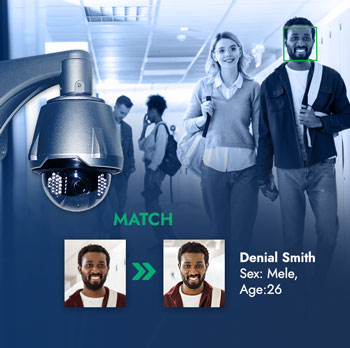Video Sentiveillance Server
Persons or vehicles recognition and tracking for video management systems (VMS)
SentiVeillance Server is a ready-to-use software for easy integration of biometric face identification, vehicle and pedestrian classification and tracking, as well as automatic license plate recognition into operating video management systems (VMS). The software analyzes live video streams, which are served by a VMS from surveillance cameras.
The list of possible uses includes law enforcement, traffic monitoring, security, attendance control, visitor counting and other applications.

SentiVeillance Server is designed to receive video streams from video management systems (VMS). SentiVeillance Server software installations and VMS installations are expected to run on separate machines and communicate over network.
There are specific requirements for VMS and SentVeillance Server software.
System Requirements for Video Management Systems (VMS)
SentiVeillance Server software uses face biometrics to perform persons identification and tracking in video streams, which are received from VMS. The results of SentiVeillance Server operations are sent back to the VMS.
A VMS should be deployed on hardware which provides enough resources for generating specified resolution video streams and storing video for a specified time frame. Please refer to VMS manufacturers for specific system requrements.
System Requirements for SentiVeillance Server Software
SentiVeillance Server software is expected to run on a dedicated PC or server hardware with Linux OS, which does not run any non-related services or applications.
- 3 GHz or better processor with 6 cores is recommended.
- AVX2 support is required. Most modern processors support this instruction set, but please check if a particular processor model supports it.
- NVIDIA GeForce GTX 1080 GPU or better is recommended for systems with up to 10 cameras.
- at least 6 GB of VRAM is recommended.
- Compute Capability 3.5 or better should be supported by the GPU.
- CUDA 10.1 toolkit or newer is required
- cuDNN 7.5 library is required.
- Ubuntu 20.04 OS
- glibc 2.17 or newer
- GStreamer 1.10.x or newer with gst-vaapi plugins installed for hardware accelerated video decoding
- libgudev-1.0 219 or newer
- wxWidgets 3.0.0 or newer libs
- head roll (tilt) – ±15 degrees from frontal position;
- head pitch (nod) – ±25 degrees from frontal position (several face views should be enrolled);
- head yaw (bobble) – ±45 degrees from frontal position (several face views should be enrolled).
- Image quality during enrollment is important, as it influences the quality of the face template.
- Several images during enrollment are recommended for better facial template quality which results in improvement of recognition accuracy and reliability.
- Additional enrollments may be needed when facial hair style changes, especially when beard or mustache is grown or shaved off.
A license for SentiVeillance Server software installation allows to analyze up to 10 video streams on a computer. The license is required for each computer that runs this software and requires activation.
License Activation Options
SentiVeillance Server software is copy-protected. The following license activation options are available:
Licenses Validity
All SentiVeillance Server software licenses are perpetual and do not have expiration. There are no annual fee or any other fees except license purchasing fee. It is possible to move licenses from one computer or device to another. Neurotechnology provides a way to renew the license if the computer undergoes changes due to technical maintenance.
